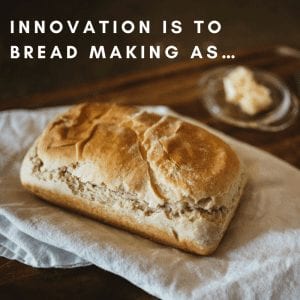 It crosses cultures. There are infinite varieties. It is a staple for most people in the world. It provides nourishment. For thousands of years we didn’t truly understand what was happening to make it work. And this fabulous invention is…Bread!
It crosses cultures. There are infinite varieties. It is a staple for most people in the world. It provides nourishment. For thousands of years we didn’t truly understand what was happening to make it work. And this fabulous invention is…Bread!
I want to share with you another way I see this – the transformation of dry flour, some water and magic into this fabulously yummy food staple… as an illustration for innovation.
Many of us have heard of the term innovation. Frequently it’s plugged in as part of a mission or vision statement; sometimes it’s plastered on a motivational poster trying to motivate you to come up with the next new thing. But seriously, what IS innovation?
Long drawn out dramatic pause…
Innovation is ideas in action.
Really implemented ones! And for anyone who has tried to entice innovation out of the dark recesses of our tacit knowledge, he or she knows how shy it can be. I’m sure you’ve all been in that beige conference room with those ever warm fluorescent lights and the task is to innovate a solution to a nagging problem. Lots of ideas and thoughts, some sound tempting… you play with them for a while…some go flat, others start to get carried away. And there you have it..it’s like working a ball of dough..sticky, temperamental and yet, when handled well, magical, mysterious and transformative… because handled well, with the help of a toasty oven, we will transform a sticky ball of water and flour into one of the world’s favorite foods…bread.
So, how is bread making similar to helping a team be innovative?
Ok – first let’s get some facts out for those of us who haven’t had the pleasure of making a mess in the kitchen transforming flour into focaccia. Bread needs three ingredients: Flour, water and yeast. That’s it. However, over the years, bakers have frequently added some other ingredients, so much so, that we consider them equally necessary: salt, sweet stuff like sugar or honey and something slippery, like oil or butter.
Now that you think you’re ready to be a baker, let’s get back to what this has to do with stimulating innovation!
Flour – the Content.
Face it…no flour, no bread. Similarly, no topic, not content… no place for innovation to happen. Think about it… flour is pretty darn inedible, but is the primary ingredient of edible bread. For innovation, we need this flour, which are the facts, the subject, the problem, the situation. This is the subject you are talking about, the arena you are in. Just like flour is the base of bread, the content is the base of the innovation process…but by itself, it’s inedible! That’s the trick… we have to have the facts, but on their own, we just have a pile of dusty white stuff.
Water – the Context.
Ok amateur bakers… even a four year old knows that to make mudpies, we need water. Water holds that wispy flour together…yup, we can make some paste, some playdough, some artificial mud. Water is the context in which our facts, our problem, our situation exists. Just like flour needs water, facts need context.
Mixing flour and water gives us the right environment for the sugars and starches to be edible in bread; similarly context provides the environment for facts to be transformed into…IDEAS. For example, I know about databases (content) and I am working with an organization to organize their client relationships (context). When I put the content of databases with the context of a client relationship database that gives me enough I can start creating some ideas from there. Ok, I just proved that I’m a nerd, but I’m also a baker…so don’t be scared off!
Interestingly, this is similar to many of our meetings… “we want the facts…when did this happen… what… when…where…how?” Great for taking a situation apart, but, using our flour-water analogy, we don’t have anything that will be bread yet. Yes, we have a beautiful icky ball of bad playdough or a soupy glop of cheap wallpaper paste…but we are NOT ready to transform this into an innovative solution. Interestingly, this is what we serve folks with our bulletized powerpoint lectures… lots of flour and water, plopped down in arial font..and then we wonder why folks leave with indigestion…better said, they don’t digest what we wanted them to consider.
Yeast – the magic pixie dust
For thousands of years, humans made bread but had no idea what yeast is…or was. But yeast is the critical ingredient. In olden days, it was saved from loaf to loaf like a precious jewel… not quite knowing what it was but knowing how to save it, nurture it and use it. Truth be told, you don’t have to buy yeast from the store…it’s in the air we breathe, but unpredictably so. ok…enough yeast science…let’s get on with our metaphor.
Yeast is the magic transformative element in bread making…it transforms the starch in the flour into a wonderful living substance that grows and becomes a bakeable mass. Yeast changes flour and water…this is key to know. Innovative ideas are our yeast…innovative ideas transform the facts and context of our situation into an opportunity; transform a problem into a solution..transform indigestible mess into delicious nutrition.
Now let’s look at how we nurture that yeast… we don’t ‘beat’ or ‘whip’ dough, we don’t use hot water or cold water… we knead dough…we plunge in with our hands and work it gently but firmly, tenderly but with muscle…kneading bread is hard work and yet it’s caressing work. We keep that dough warm, moist and we let it rise. We let it change the shape of our dough…transform the flour and water. So if you want to let those ideas transform your problem, you can’t whip or beat your people..you can’t throw cold water on their ideas… otherwise, you’ll just leave that room with a sticky pile of pasty dough and need to go to a bakery…shameless plug for hiring a consultant baker!
That is the secret to this analogy. When we want to transform our problems into solutions, we need to carefully knead those ideas into the mixture…and let them work their magic. Let it get carried away. Just like a dough ball will rise, and then deflate and rise and deflate, so will our innovation-nurturing conversation. As I mentioned before, flour and water is enough all on its own to attract yeast from the air we breathe IF given enough time and encouragement. This tells me that I don’t have to get fancy; ideas will naturally flow if given the right environment.
Those other ingredients…
Salt – reality, common sense
What does salt do for bread? Yes it gives it flavor, but, more importantly, salt keeps the yeast transformation in check. Yeast eats the sugars and produces more yeast, carbon dioxide and alcohol. While we like when it does that in a slurry we call wort, when yeast tranforms wheat sugar into beer, we don’t really want that in our bread. How much salt do we need? Just a pinch.
For our analogy, salt is the pinch of common sense, the experience factor. Interestingly, when we load up the conference room, we frequently think that the best way to innovate a solution is to fill the seats with ‘old salts’…those with lots of experience. Hmmm. Flour, water, salt… that makes…oh yea, playdough. Just the right amount of salt, that pinch, is enough to keep that yeast well behaved… eating, multiplying and burping… but not turning our bread into sliceable beer. Too much salt… no growth. Too much experience, no new idea has a chance…it will be poisoned at the start. Face it, we need the salt…but just a pinch for tasty bread. Our new ideas can be better grown with a similar pinch…but that’s it, a pinch. In a funny coincidence, the amount of yeast is pretty darn equal to the amount of salt in most bread recipes…especially in comparison to the amount of bread and water. So… that’s a pretty good way to plan your next innovation baking session… content, context, some yeast, and a pinch of experience.
Sugar – feed the yeast… Bright spots
Yes, you can make bread without sugar, but sugar is the yeast appetizer… it gets the yeast to wake up. Ok, yes, the yeast is on a sugar high. Once awake, the yeast will happily start transforming the starch in the flour. So, that’s the key. Innovative ideas need an artificial, sweet start before munching into the real content. That’s why tactics like benchmarking and triz and those embarrassing team building games are so counter-intuitively successful…they kick start the yeast of our good ideas. Once it’s awake, then it can be easily added to the sticky mess of our content and context. Just like sugar jolts the yeast awake, so too do bright spots in other areas of industry, your business or, as we find frequently, in mother nature. Now, let’s take this metaphor to a crazy but remarkably true extreme…feed your people sugar if you want good innovation to grow at a meeting? Yup…starting an innovation session at 2:30 in the afternoon is like trying to get old yeast to start in a pile of whole wheat flour. But, if you get the folks some energy…say raisins and chocolate…you might be quite pleased at how this will kick start the yeast of your session.
Oil/Butter – Making it Last
In bread, oil or butter provides staying power so the bread stays fresh longer. For our ideas, this is the things we do to prepare our idea for the real world and prepare the environment for the idea. This will help the idea survive in the real world long enough to take hold and be useful…for nourishment!
Baking – Heat to transform it, make it beautiful.
Finally our bread is ready to bake, to go into the real world to be tested and used. Interestingly, the yeast dies at this point and only it’s impression is left behind in the bubbles of the bread. When our ideas make it into the organization, the idea itself transforms into something else. It’s no longer dough; it’s bread. This is where our idea makes its mark. Unless an idea is implemented and becomes something for real organizational food, then it really isn’t worth much. Implementation is essential in innovation.
So in many ways the process of creating bread is similar to the elements of innovation.
Bread is fundamental to nourishment…survival.
Innovation is fundamental to survival in the market.
But how do we coax our yeast of ideas into yummy loaves? Plan your innovation meeting just like a baker plans to transform flour…bring lots of content and context…be ready to put them together in a messy way… prepare to roll up your sleeves and get messy with it…have a way to wake up the new ideas…some sugar water for the people and the ideas (think games, think stories, think looking at other great ideas and using that for your situation)…throw in a pinch of salt…knead it with muscle and tenderness in a well facilitated session…be ready to have the dough…the conversation…rise and fall and rise again…keep the yeast growing with the warm environment of trust and respect…be ready to add some oil or butter to make it last…think planning tools like schedules, roles and responsibility charts…then gently bake it in a beta case or pilot run…serve and slice while warm.
Do you want to get intoxicated with new ideas? Ok…that’s another story about liquid bread…beer…making. All the grain, all the yeast and none of the salt.
For some reason, I’m in the mood to go the bakery… catch you later.





